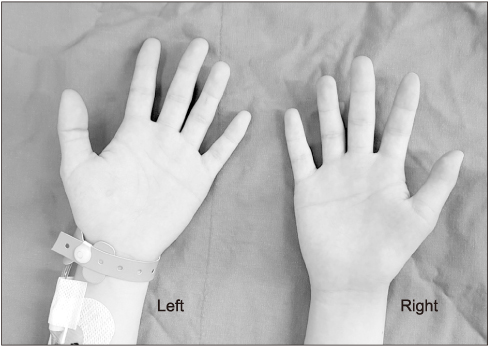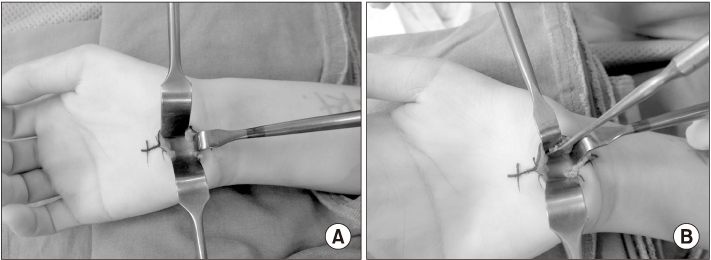J Korean Orthop Assoc.
2019 Oct;54(5):452-456. 10.4055/jkoa.2019.54.5.452.
Carpal Tunnel Syndrome Caused by Persistent Median Artery and Bifid Median Nerve in an Adolescent
- Affiliations
-
- 1Department of Orthopedic Surgery, Incheon St. Mary's Hospital, College of Medicine, The Catholic University of Korea, Incheon, Korea. sjoo@catholic.ac.kr
- KMID: 2461236
- DOI: http://doi.org/10.4055/jkoa.2019.54.5.452
Abstract
- Carpal tunnel syndrome is rare in children. When it does occur in children, the most common causes reported are mucopolysaccharidosis and mucolipidosis. The median artery is a transitory vessel that develops from the axillary artery in early embryonic life and does not normally survive until postfetal life. In a small percentage of individuals, however, it persists into adulthood and is frequently accompanied by a bifid median nerve. A persistent median artery can be a cause of carpal tunnel syndrome in adults, but it is extremely rare in children and adolescents. This paper reports a case of a carpal tunnel syndrome caused by a persistent median artery and bifid median nerve in a 13-year-old girl.
Keyword
MeSH Terms
Figure
Reference
-
1. Leti Acciaro A, Pilla F, Faldini C, Adani R. The carpal tunnel syndrome in children. Musculoskelet Surg. 2018; 102:261–265.
Article2. Batdorf NJ, Cantwell SR, Moran SL. Idiopathic carpal tunnel syndrome in children and adolescents. J Hand Surg Am. 2015; 40:773–777.
Article3. Barfred T, Højlund AP, Bertheussen K. Median artery in carpal tunnel syndrome. J Hand Surg Am. 1985; 10:864–867.
Article4. Carry PM, Nguyen AK, Merritt GR, et al. Prevalence of persistent median arteries in the pediatric population on ultrasonography. J Ultrasound Med. 2018; 37:2235–2242.
Article5. Lanz U. Anatomical variations of the median nerve in the carpal tunnel. J Hand Surg Am. 1977; 2:44–53.
Article6. Bayrak IK, Bayrak AO, Kale M, Turker H, Diren B. Bifid median nerve in patients with carpal tunnel syndrome. J Ultrasound Med. 2008; 27:1129–1136.
Article7. Fowler JR, Gaughan JP, Ilyas AM. The sensitivity and specificity of ultrasound for the diagnosis of carpal tunnel syndrome: a meta-analysis. Clin Orthop Relat Res. 2011; 469:1089–1094.
Article8. Propeck T, Quinn TJ, Jacobson JA, Paulino AF, Habra G, Darian VB. Sonography and MR imaging of bifid median nerve with anatomic and histologic correlation. AJR Am J Roentgenol. 2000; 175:1721–1725.
Article9. Bilgin SS, Olcay SE, Derincek A, Adiyaman S, Demirtas AM. Can simple release relieve symptoms of carpal tunnel syndrome caused by a persistent median artery? Clinical experience. Arch Orthop Trauma Surg. 2004; 124:154–156.10. Aulicino PL, Klavans SM, DuPuy TE. Digital ischemia secondary to thrombosis of a persistent median artery. J Hand Surg Am. 1984; 9:820–823.
Article
- Full Text Links
- Actions
-
Cited
- CITED
-
- Close
- Share
- Similar articles
-
- Thrombosed Persistent Median Artery with Bifid Median Nerve Causing Acute Carpal Tunnel Syndrome: A Case Report
- The Ultrasonographic Findings of Bifid Median Nerve
- Thrombosed Fusiform Dilatation of Persistent Median Artery with Normal Median Nerve
- Carpal tunnel syndrome caused by thrombosed persistent median artery - A case report -
- Median Nerve Block for Treatment of Carpal Tunnel Syndrome: Report of 5 cases




